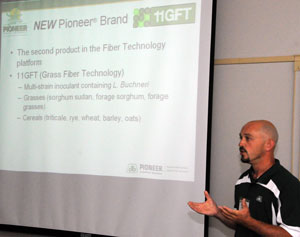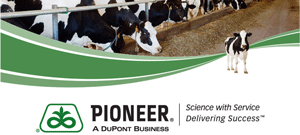 Everyone has a different idea of who or what a cowboy is. While most definitions vary widely, there is one thing that they all have in common: pride in American agriculture and dedication to get the job done right. Recently, I ran across an article titled, “Who Cares About Cowboys Anymore?” and it discussed how the average American consumer doesn’t care or understand where their food comes from. (Photo Credit: Peter Yang, True Grit)
Everyone has a different idea of who or what a cowboy is. While most definitions vary widely, there is one thing that they all have in common: pride in American agriculture and dedication to get the job done right. Recently, I ran across an article titled, “Who Cares About Cowboys Anymore?” and it discussed how the average American consumer doesn’t care or understand where their food comes from. (Photo Credit: Peter Yang, True Grit)
Today, I’m asking each and every single AgWired reader out there to share their definition of the American cowboy. Leave it in the comments section here, as well as on the article. It’s time we connect with our urban customers once again. It’s time they understand the people behind the products in the grocery stores. It’s time we stand up and speak out before our story gets told by someone else. Remember to share the facts and your personal story to deliver the most effective message. Here is my comment that I left on the website… I hope you’ll take the time to share your story, too.
It’s been said that most Americans are so far removed from American agriculture, they have never even met a farmer/rancher in their lifetimes. However true that may be, I thought I would take this opportunity to introduce myself to the American public as a fifth generation cattle rancher from South Dakota. My name is Amanda Nolz, and my family has been in the cattle business in what seems like forever.
Ranching is a tough profession, especially today, with the increasing price of food, fuel and fiber, and it’s not always easy to earn a living in this career. It’s tough, but necessary work. According to the most recent agriculture census, for every consumer dollar spent on food in the United States, the farmer or rancher only receives 18 cents of that dollar. However, despite the challenges, the people involved in raising food are a passionate group. Over 90% of farms and ranches are family owned and operated, which means that families just like yours are dedicated to raising a safe, affordable wholesome food source that is abundantly available for families across the globe.
For me and my family, we are proud to raise nutritious, delicious beef. It graces our dinner table on most nights. Despite the common misconceptions in the media today about our nation’s food supply, we firmly believe that American farmers and ranchers produce the safest food in the world. Maybe you have never met a cowboy before, but I hope that you will remember people like me that are working hard everyday to fill the center of your dinner plate. We are “cowboys,” and it’s a lifestyle we are dedicated to, no matter how difficult it gets at times.
Amanda Nolz
5th generation cattle rancher
Mitchell, SD
 The man who got us started here at the Pioneer Hi-Bred Forage Media Day is Robin Newell. Cindy spoke to him about the “long look.” He says the Pioneer long look has four components that include: “We strive to create the best products;” “We deal honestly and fairly with our constituents;” “We represent our products vigorously;” “We help our customers get the most from our products.” He says the focus today on the development of corn silage and alfalfa and inoculants like their new 11GFT.
The man who got us started here at the Pioneer Hi-Bred Forage Media Day is Robin Newell. Cindy spoke to him about the “long look.” He says the Pioneer long look has four components that include: “We strive to create the best products;” “We deal honestly and fairly with our constituents;” “We represent our products vigorously;” “We help our customers get the most from our products.” He says the focus today on the development of corn silage and alfalfa and inoculants like their new 11GFT. 
 Since I have returned to my family’s cattle operation, I’ve quickly been put in charge of all marketing efforts. For the fair, I developed a brochure about our business, as well as designed stall cards to display information about our cattle. My next task is improving our website (it’s in need of dire help), and starting up a newsletter for our customers.
Since I have returned to my family’s cattle operation, I’ve quickly been put in charge of all marketing efforts. For the fair, I developed a brochure about our business, as well as designed stall cards to display information about our cattle. My next task is improving our website (it’s in need of dire help), and starting up a newsletter for our customers. The news here at the Pioneer Hi-Bred Forage Media Day is a new product. The
The news here at the Pioneer Hi-Bred Forage Media Day is a new product. The  The Pioneer Forage Media Day has started with class in session at their Livestock Nutrition Center near Des Moines, IA. We have a very good attendance from the ag media. Cindy (
The Pioneer Forage Media Day has started with class in session at their Livestock Nutrition Center near Des Moines, IA. We have a very good attendance from the ag media. Cindy (

 In just a few days
In just a few days  National FFA members will be getting an education in the growing field of renewable fuels, thanks to a new partnership.
National FFA members will be getting an education in the growing field of renewable fuels, thanks to a new partnership. The
The  In this weeks program I chat with new a
In this weeks program I chat with new a  Heres a photo of Tom I took from a Farm Foundation Forum I attended. In fact, as I looked back through posts here on AgWired, hes been kind of a regular! Were really looking forward to working with Tom in his new position.
Heres a photo of Tom I took from a Farm Foundation Forum I attended. In fact, as I looked back through posts here on AgWired, hes been kind of a regular! Were really looking forward to working with Tom in his new position.